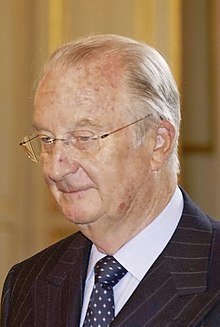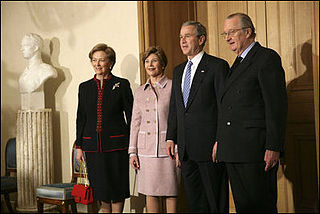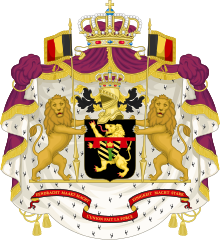Loading AI tools
King of the Belgians from 1993 to 2013 From Wikipedia, the free encyclopedia
Albert II[a] (born 6 June 1934) is a member of the Belgian royal family who reigned as King of the Belgians from 9 August 1993 until his abdication on 21 July 2013.
| Albert II | |
|---|---|
 Albert II in 2010 | |
| King of the Belgians | |
| Reign | 9 August 1993 – 21 July 2013 |
| Predecessor | Baudouin |
| Successor | Philippe |
| Prime ministers | |
| Born | 6 June 1934 Château of Stuyvenberg, Laeken, Brussels, Belgium |
| Spouse | |
| Issue | |
| House | Belgium |
| Father | Leopold III of Belgium |
| Mother | Astrid of Sweden |
| Religion | Roman Catholicism |
| Signature | |
Albert II is the son of King Leopold III and the last living child of Queen Astrid, born a princess of Sweden.[b] He is the younger brother of the late Grand Duchess Joséphine-Charlotte of Luxembourg and King Baudouin, whom he succeeded following Baudouin's death in 1993. He married Donna Paola Ruffo di Calabria (now Queen Paola), with whom he had three children. Albert's eldest son, Philippe, is the current King of the Belgians.
On 3 July 2013, King Albert II attended a midday session of the Belgian cabinet. He then announced that, on 21 July, Belgian National Day, he would abdicate the throne for health reasons. He was succeeded by his son Philippe on 21 July 2013. Albert II was the fourth monarch to abdicate in 2013, following Pope Benedict XVI, Queen Beatrix of the Netherlands, and Emir Hamad bin Khalifa of Qatar.[3] In so doing, he was also the second Belgian monarch to abdicate, following his father, Leopold III, who abdicated in 1951, albeit under very different circumstances.
Prince Albert was born at the Château of Stuyvenberg in Laeken, northern Brussels, as the second son and youngest child of King Leopold III and his first wife, Princess Astrid of Sweden. He was second in line to the throne at birth, and was given the title Prince of Liège. When Prince Albert was one year old, Queen Astrid died in Switzerland in a car accident on 29 August 1935, in which King Leopold, who was driving the vehicle, was lightly injured. The King remarried to Mary Lilian Baels (later became Princess of Réthy) in 1941. The couple produced three children: Prince Alexandre, Princess Marie-Christine and Princess Marie-Esméralda (who is also Albert's goddaughter). Albert and his siblings had a close relationship with their stepmother and they called her "Mother".[4][5]
During World War II, on 10 May 1940, at the time when Belgium was being invaded, Prince Albert, his elder sister Princess Joséphine-Charlotte and his elder brother Prince Baudouin, left the country for France and later Spain. The Prince and the Princess returned to Belgium on 2 August 1940. They continued their studies until 1944, either at Laeken, or at the Castle of Ciergnon in the Ardennes. In June 1944, at the time of the Allied landings, King Leopold, his wife Princess Lilian and the royal children were deported by the Germans to Hirschstein, Germany, and later to Strobl, Austria, where they were released by the American 106th Cavalry Regiment on 7 May 1945. Owing to the political situation in Belgium, King Leopold and his family moved to the villa "Le Reposoir" in Pregny, Switzerland, when they left Austria in October 1945 and stayed until July 1950. During that time, Prince Albert would continue his education in a secondary school in Geneva. King Leopold III, accompanied by Prince Baudouin and Prince Albert, returned to Belgium on 22 July 1950.[6]


In 1958, Albert went to the Vatican to witness the coronation of Pope John XXIII. At a reception at the Belgian Embassy, he met Italian Donna Paola Ruffo di Calabria. Prince Albert proposed marriage to her, to which she accepted. Two months after their meeting, the prince introduced his future wife to his family, and four months later to the press. The couple were married on 2 July 1959, one-and-a-half years before Albert's older brother, the king, got married (a marriage which would prove childless). Albert and Paola have three children, twelve grandchildren and three great-grandchildren. Their children are:
In 1997, the Belgian satirical magazine Père Ubu reported that the Belgian sculptor Delphine Boël (born 22 February 1968) was King Albert II's extramarital daughter.[7] It took some years for the Belgian mainstream media to report this news. According to Baroness Sybille de Selys Longchamps, the mother of Delphine, she and Albert shared an 18-year-long relationship[8] into which Delphine was born.
In June 2013, Boël summoned the then King and his two older children (the then Duke of Brabant and the Archduchess of Austria-Este) to appear in court. She hoped to use DNA tests to prove that she is the King's daughter. As the King enjoyed complete immunity under the law, Boël decided to summon his elder children as well.[9][10] The king abdicated the following month, in July 2013. After the King's abdication, Boël abandoned her first suit to introduce a second one only against the former King as he was no longer protected by immunity and the first claim would have been judged according to the situation at the time of the introduction of the claim.[11]
In March 2017, the Court ruled that her claim was unfounded, and her lawyers said she would take the claim to appeal.[12] On 25 October 2018, the Court of Appeal decided that Delphine Boël is not a descendant of Jacques Boël, and ordered King Albert to undergo DNA testing. His lawyer announced that he would seek further advice about a possible referral to Belgium's Cour de Cassation / Hof van Cassatie.[13] In 2019, the King's lawyer confirmed he would not provide a DNA sample in the case.[14]
On 29 May 2019, it was reported by CNN that Albert II had submitted a DNA sample after a Belgian court ruled on 16 May that he would be fined 5,000 euros for each day that he failed to do so, although he would continue to challenge the ruling, according to his attorney, Alain Berenboom.[15][16] The results of these DNA samples were released on 27 January 2020 by Alain Berenboom, confirming Delphine Boël as Albert II's daughter. Albert II confirmed this on 27 January 2020 in a press release.[17] "The king will treat all his children as equal," Berenboom said, according to VTM News. "King Albert now has four children."[18]
While it was proven that Boël was his biological daughter, her legal status as a daughter was not recognized[19][20] until a 1 October 2020 ruling of the Brussels Court of Appeal, which also recognized Boël as a princess of Belgium and granted her the new surname of Saxe-Coburg.[21]

As the younger brother of the childless King Baudouin, Prince Albert was the heir-presumptive to the throne. Albert's son Philippe was groomed to eventually succeed. On Baudouin's death, Albert was sworn in before parliament, on 9 August 1993, as King of the Belgians.[22]
As King, Albert's duties included representing Belgium at home and abroad on state visits, trade missions, and at high level international meetings as well as taking an interest in Belgian society, culture and enterprise.[23] The King had a constitutional role which came into play in 2010–2011 when Belgium's parliament was unable to agree on a government. When the crisis was resolved, Albert swore in the new government.[24]
In 1984, he set up the Prince Albert Foundation, to promote expertise in foreign trade.[25]
Albert sparked controversy in his December 2012 Christmas speech by comparing modern "populist movements" with those of the 1930s. This was seen by several political commentators, as well as many Flemish politicians, as aimed implicitly at the large Flemish nationalist party, the N-VA.[26] Bart De Wever, the party's leader, called for the King's role in the formation of Belgian governments to be changed in the wake of this comment since he "could no longer see the monarch as playing the constitutional role of referee."[26]
On 3 July 2013, 79-year-old King Albert II attended a midday session of the Belgian cabinet, where he revealed his intention to abdicate to Prime Minister Elio Di Rupo and to the deputy prime ministers. This came less than one month after the king and two of his children had been asked to appear in court by the Belgian sculptor Delphine Boël, who was intent on proving that the king was her biological father. According to a letter sent by the King to the Prime Minister and dated 3 July 2013, and which was made public, the King had already broached the topic of his intention to abdicate several times with the Prime Minister, who had asked him to reconsider it.[27] At 6 pm (CET) the King announced in a recorded radio and television speech that on 21 July, Belgium's National Day, he would abdicate the throne for health reasons. He was succeeded by his elder son, Philippe.[3]
After his abdication on 21 July 2013 it was decided that he would be styled as His Majesty King Albert II,[28] the same form of address granted to his father, Leopold III, after his abdication.



As King (1993-2013) he was Grand Master of:
King Albert II is Doctor Honoris Causa of:
 |
|
| Ancestors of Albert II of Belgium |
|---|
Seamless Wikipedia browsing. On steroids.
Every time you click a link to Wikipedia, Wiktionary or Wikiquote in your browser's search results, it will show the modern Wikiwand interface.
Wikiwand extension is a five stars, simple, with minimum permission required to keep your browsing private, safe and transparent.